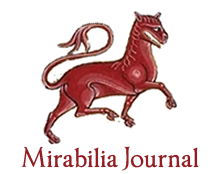Arcadian Edens, Edenic Paradises and Salvific Gardens
Antonio CORTIJO OCAÑA
Original title: Edenes arcádicos, paraísos edénicos y jardines salvíficos
Published in Returning to Eden
Keywords: Arcadia, Eden, Hortus Conclusus, Paradise, Utopia.
Eden or Paradise is one the most disseminated concepts in Christendom and the western world. From its Persian origin, this article traces its development through its Arcadian classical manifestations, its medieval modification as hortus conclusus and its pastoral and utopian elements in the Renaissance.
Army, game, and social order: an approach to the cosmic metaphor of the justification of war in De bello by Juan de Legnano
Emiliano ALDEGANI; Lucía GARCÍA ALMEIDA
Original title: Ejército, juego y orden social: una aproximación a la metáfora cósmica de la justificación de la guerra en De bello de Juan de Legnano
Published in Games from Antiquity to Baroque
Keywords: Game, Huizinga, Legnano, Middle Ages, War.
The aim of this paper is to point out the articulation between the celestial order and the military order expressed in the work of the medieval jurist John of Legnano (14th century) in the Tractatus de Bello, de Represaliis et de duello. In the introduction to his book, he states that ‘human war’ reflects war in the divine order, which leads the author to justify the military conflicts present in his time as coming from God, a hypothesis that he supports based on the testimonies offered by the Gospels. Thus, in the first chapter, he divides war into Spiritual, celestial, or human warfare and Corporal, universal or warfare. In addition, some central ideas of the medievalist Johan Huizinga, in his work Homo ludens, on the sacred meaning of victory in the context of medieval military confrontations, which is deeply related to the meaning of victory in the game, will be recovered. Based on this key reading, the aim is to contextualise Legnano's conception within the framework of the canonical understandings of the foundations of war conflicts that prevailed in the late medieval period.
Art and History: the genesis of the monarchy conception in the Christian West (IV-VI centuries)
Ricardo da COSTA
Original title: Arte e História: a gênese da concepção monárquica no Ocidente cristão (sécs. IV-VI)
Published in Idea and image of royal power of the monarchies in Ancient and Medieval World
Keywords: Christianity, Clovis I, Constantine, Middle Ages, Monarchy, Theodosius I, the Great.
The article examines the birth of the Monarchy in the Medieval West. To do it, three paradigmatic cases that helped to build the monarchical ideal are analyzed: the conversions to Christianity of Constantine the Great (272-337) and King Clovis I (c. 466-511), beyond the submission of Theodosius I (347-395) to the Roman Catholic Church, with their corresponding images (fresco, painting, sculpture, coin, illumination, tomb).
Arte da Caça de Altanaria: an portuguese example of cinegetics literature of XVII Century
Alice TAVARES
Original title: Arte da Caça de Altenaria: um exemplar português de literatura cinegética do século XVII
Published in Medieval and Early Modern Iberian Peninsula Cultural History
Keywords: Birds, Cinegetics literature, Falconry, Hunting.
This article has the objective of showing the Hunting art of Diogo Fernandes Ferreira, and also to send some clues and questions to future investigations about the hunting activity with the use of poultry. We also want to emphasize the importance of hunting in the Portuguese modern society, mainly in a certain moment, in which this activity was “sleeping”. This is a work of Portuguese literature about hunting, written by a royal falconer in the first quarter of the XVII century.
Ascensio in Deum per vestigia et in vestigiis. The St. Bonaventure’s immanent Aesthetics and its possible reflections in the iconography of the Basilica of St. Francis in Assisi
José María SALVADOR GONZÁLEZ
Original title: Ascensio in Deum per vestigia et in vestigiis. La Estética inmanente de San Buenaventura y sus posibles reflejos en la iconografía de la Basílica de San Francisco en Asís
Published in Monastic and Scholastic Philosophy in the Middle Ages
Keywords: Aesthetics, Basilica of St. Francis in Assisi, Created world, God, Iconography, Medieval Philosophy, St. Bonaventure, Vestige.
In his Itinerarium mentis in Deum (1259), St. Bonaventure (1221-1274) discusses the six degrees (with a seventh of ecstatic enjoyment) by which man can and should ascend from the created world to contemplate God. In this paper we will analyze only the first two grades of this Itinerarium, which constitute both of them what we might call the “immanent aesthetic” of St. Bonaventure. Highlighting then two of the central theses of this “immanent aesthetic”, we shall try to show the possible reflections that these theses may have had in the iconography of some frescoes in the Basilica of St. Francis in Assisi.
Astragalomanteion, Sortes Sanctorum, Sortes Monacenses: stratification of gaming practices and cultural traditions from Early Antiquity to the Middle Ages
Marco TIBALDINI
Published in Games from Antiquity to Baroque
Keywords: Ancient divinatio, Astragalomanteia, Astragals, Casting lots, Dice, Homeromanteia, Knucklebones, Lots, Medieval divination, Oracle, Sortes Monacenses, Sortes Sanctorum.
This paper analyses the complex relation between board games and divination, and the role those randomizing elements like dice and knucklebones played in it. It presents several literary quotations that show how the tradition of casting lots to take important decisions was diffused. It includes pieces of Sumerian and Akkadian, Hebrew, Greek and Latin literature referred to lots, and especially those related to the use of knucklebones and dice. It also outlines the stratification of divinatory practices based on gaming tools since the antiquity to the late Middle Age. It analyses the Astragalomanteia and Homeromanteia, and their points of contact with the Sortes Sanctorum and the Sortes Monacenses.
Banquets of Ladies and Gentlemen: eating, ceremony and table-etiquette of Habsburg's court in Spain and Portugal (16th and 17th centuries)
Ana Paula Torres MEGIANI
Original title: Banquetes de damas e cavaleiros: alimentação, cerimonial e etiqueta de mesa na corte dos Habsburgo em Espanha e em Portugal (sécs. XVI e XVII)
Published in Medieval and Early Modern Iberian Peninsula Cultural History
Keywords: Courtly etiquette, Eating ceremonies, Hispanic monarchy, Iberian courts.
One of the most remarkable characteristics of modern European monarchies was the adoption of the etiquette system in the habits of the royal household and noblemen in general. This system relates structurally to the building of hierarchies and the creation of symbolic attributes within the courts. This article presents a contribution to the studies regarding the rapport between courtly etiquette and eating ceremonies, either public or private, during the reigns of monarchs from the House of Habsburg, since Charles V to Philip III of Spain.
Beliefs, Values and Social Representations of Normal Birth
Luciano Antonio RODRIGUES, Bruno Alves da SILVA, Priscila Margarete Araújo Beserra VALENTIM
Original title: Crenças, Valores e Representações Sociais do Parto Normal
Published in
Keywords: Childbirth Assistance, Normal Birth, Social representation, Women's Health.
Abstract: Introduction: Giving birth is a special moment in the women universe, since it brings new feelings in the very essence of being a woman: the act of being a mother is central. Pregnancy and delivery links men’s reproduction aspects as well as women’s, involving their families and the community. Everyone who participates in this experience are enriched by hope and the joy it brings, bringing up feelings that defines a human being. Objective: to learn how vaginal birth seems like to women having their first child, how it affects social characteristics as well as beliefs and values. Methodology: this is a short-term exploratory study with 15 first child mothers regarding qualitative and describing views. The study was done in a maternity hospital in the city of Colatina, Espírito Santo, Brazil. The data was collected through recorded interviews based on a semi-structured script, its variables related to social and demographic differences, approaching their experiences towards vaginal birth. Data was analyzed by the Lerass’ software IRaMuTeQ version 0.6 Apha 3, in which it was possible to achieve content about the interviews, word cloud creation and similarities analysis. Conclusion: Vaginal birth is socially associated with pain, related not only to suffering but also to the idea of overcoming. Another subject to consider is the ignorance towards the procedure. That generates hopes, uncertainties, fears and anxiety. One of the great challenges for shifting the paradigm of vaginal birth is the deconstruction of negative feelings and beliefs, bringing back women’s independency and the joy of giving birth. To give birth is an act that should be one of the greatest experiences of women inside her reality and accordingly to her unique role in what is one of the most important part in the great universe that is human birth.
Benedicta in mulieribus. The Virgin Mary as a paradigm of women in the patristic tradition and its possible reflection in Spanish Gothic painting
José María SALVADOR GONZÁLEZ
Original title: Benedicta in mulieribus. La Virgen María como paradigma de la mujer en la tradición patrística y su posible reflejo en la pintura gótica española
Published in Mulier aut Femina. Idealism or reality of women in the Middle Ages
Keywords: Iconography, Mariology, Paradigm, Patristics, Spanish Gothic painting., Theology, Women.
From the first centuries of the Christian era the Virgin Mary became in respect of the believers a sublime and inimitable model of human, moral and spiritual virtues. This fact has been staged by researchers on Marian iconography as a self-evident axiom, which need not be explained or justified documentarily. Going against this uncritical stance, this paper aims to explain, through a lot of theological and patristic citations, three fundamental aspects or attributes, in which, among many others, the paradigmatic character of Mary becomes real: her supereminence in comparison with the other women, her supereminence in comparison with the other creatures, including angels and saints, and her intercession before God on behalf of human beings. We complement our study by a comparative analysis through which we attempt to relate these patristic and theological sources with some Spanish Gothic paintings in which the three mentioned aspects of the analyzed Marian doctrine could be reflected in some way.






















































































